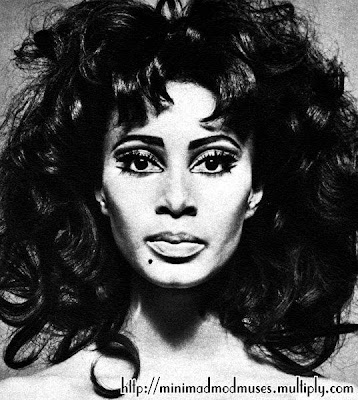An American model and cover girl. She also appeared in several films, in Camp (1965) by Andy Warhol, Qui êtes-vous, Polly Maggoo? (1966) by William Klein, as Groucho Marx's companion in Otto Preminger's Skidoo (1968), and most notably as Oenothea in Federico Fellini's Satyricon (1970) and as the title character in Salomé (1972), a film by director Carmelo Bene.
She was born
Peggy Ann Freeman in Detroit, Michigan. She attended the prestigious Cass Technical High School. Her parents were Peggy and Nathaniel Freeman; her mother killed her father, who was reportedly abusive, when Donyale was 18. Luna's mother wanted her to become a nurse.
Despite the parentage stated on her birth certificate, she insisted that her biological father was a man with the surname Luna and that her mother was Indigenous Mexican and of Afro-Egyptian lineage. According to the model, one of her grandmothers was reportedly an Irish former actress who married a black interior decorator. Whether any of this background is true is uncertain. In the mid 1960s, a relative described Luna as being "a very weird child, even from birth, living in a wonderland, a dream."
After being discovered by the photographer David McCabe, she moved from Detroit to New York City to pursue a modeling career. In January 1965, a sketch of Luna appeared on the cover of
Harper's Bazaar.
She became the first African American model to appear on the cover of a
Vogue magazine, the March 1966 British issue, shot by British photographer David Bailey.
According to
The New York Times, she was under exclusive contract to the photographer Richard Avedon for a year at the beginning of her career.
An article in
Time magazine published on 1 April 1966, "The Luna Year", described her as "a new heavenly body who, because of her striking singularity, promises to remain on high for many a season. Donyale Luna, as she calls herself, is unquestionably the hottest model in Europe at the moment. She is only 20, a Negro, hails from Detroit, and is not to be missed if one reads
Harper's Bazaar,
Paris Match, Britain's
Queen, the British, French or American editions of
Vogue.
In 1967, the mannequin manufacturer Adel Rootstein created a mannequin in Luna's image, a follow-up to the company's Twiggy mannequin of 1966.
During the late 1960s and early 1970s, Luna appeared in several films.
She appeared in several movies produced by Andy Warhol. These included
Screen Test: Donyale Luna (1964), in which critic Wayne Koestenbaum described Luna as "pure diva, presenting a delicious mobile excess of mannerism";
Camp (1965), and
Donyale Luna (1967), a 33-minute color film in which the model starred as Snow White.
In Federico Fellini's
Fellini Satyricon (1970), she portrayed the witch Oenothea, "who," according to one commentator, "in a trade-off with a wizard long ago ended up with fire between her legs. And it's real fire too, because Fellini shows us a scene in which a long line of foolish-looking peasants wait with unlit torches at Oenothea's bed. When their time comes, each devoutly places his torch between her legs to her sex, and, Poof."
Luna also appeared in
The Rolling Stones Rock and Roll Circus, the Otto Preminger comedy
Skidoo (in which she was featured as the mistress of crime boss "God", who was portrayed by Groucho Marx), and the British documentary
Tonite Let's All Make Love in London.
Luna starred as the title character in the 1972 Italian film
Salomé, by director Carmelo Bene.
According to the journalist Judy Stone, who wrote a profile of Luna for
The New York Times in 1968, the model was "secretive, mysterious, contradictory, evasive, mercurial, and insistent upon her multiracial lineage -- exotic, chameleon strands of Indigenous-Mexican, Indonesian, Irish, and, last but least escapable, African." A London magazine (The Sunday Times Magazine, article by Harold Carlton) hailed her as "the completely New Image of the Negro woman. Fashion finds itself in an instrumental position for changing history, however slightly, for it is about to bring out into the open the veneration, the adoration, the idolization of the Negro ... "
When Stone asked her about whether her appearances in Hollywood films would benefit the cause of black actresses, Luna answered, "If it brings about more jobs for Mexicans, Asians, Native Americans, Africans, groovy. It could be good, it could be bad. I couldn't care less."
In the mid 1960s, Luna was married to an actor for 10 months. Later she reportedly was engaged to the Austrian-born Swiss actor Maximilian Schell, to an unnamed Danish photographer, and to Georg Willing, a German actor who appeared in European horror films (such as 1970's "Necropolis") and with the Living Theatre.
Around 1969 Luna was also romantically involved with German actor Klaus Kinski. Both posed together on several photographs. The relationship ended when Kinski asked her entourage to leave his house in Rome: he was concerned that their drug use could damage his career.
Luna married the Italian photographer Luigi Cazzaniga. In 1977 they had a child: Dream Cazzaniga.
April 1975 Donyale told Playboy Magazine "I’m not a model, I’m an artist, I do modeling and acting as a part of my artistry; instead of a paintbrush and canvas, I use film.
I have many visions of myself when I go through photographic trips, I’ve gone through periods from Nerfertiti to Josephine Baker.
Berry Gordy’s 1975 film Mahogany was loosely base on Luna’s rise to the top of the fashion world,
but...without the Hollywood ending.
On May 17, 1979– Luna died in Rome, Italy, in a clinic, after an accidental drug overdose of presentation sleeping pills. She was only 34 years old.
Donyale Luna was only the tip of an iceberg when it comes to black women in Fashion.
Many more followed.
Donyale Luna
(August 31, 1945 – May 17, 1979)



















